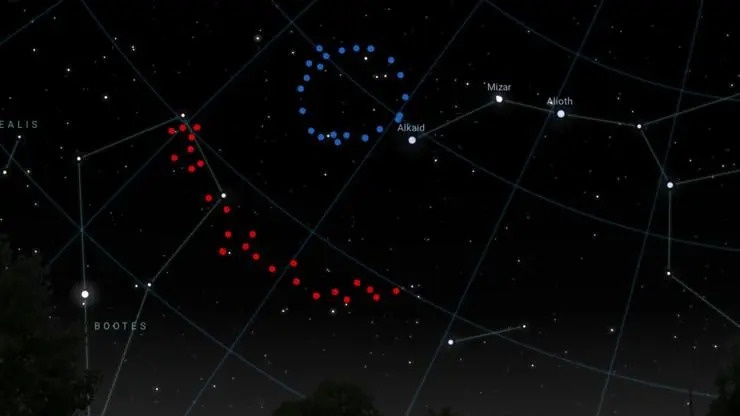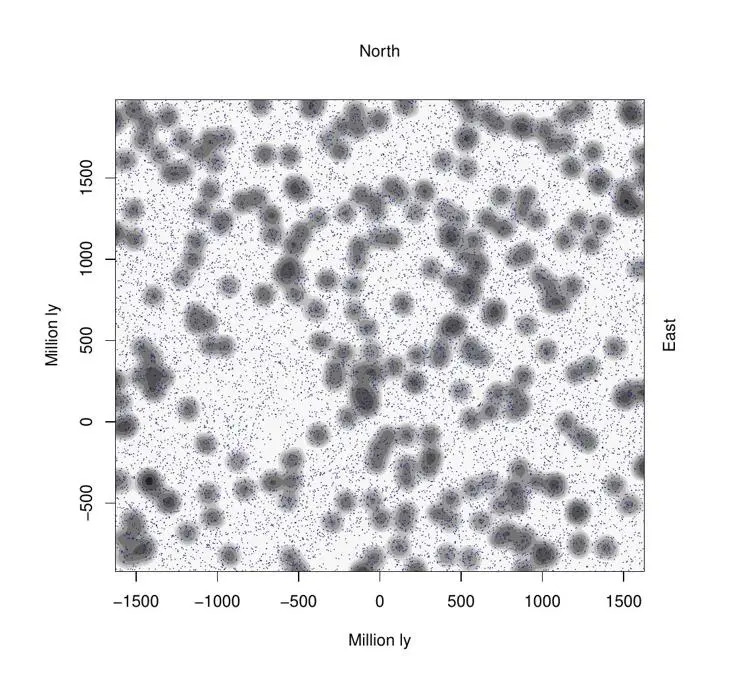An impossibly huge ring of galaxies might lead us to new physics. Here's how
The ring of galaxies, appropriately called the "Big Ring," has a circumference of nearly 4 billion light-years.

An intergalactic ring-shaped superstructure of galaxies and galaxy clusters — so large it defies explanation — has been discovered. This is a structure that lives so deep in the universe that we see it as it was some 9.2 billion years ago.
The huge superstructure, nicknamed the "Big Ring," spans 1.3 billion light-years in diameter and has a circumference of about 4 billion light-years. It is also close to another immense superstructure, the "Giant Arc in the Sky," which is actually even larger with a diameter of 3.3 billion light-years. The Giant Arc sits at a similar distance to us in the constellation of Boötes, the Herdsman. Alas, these superstructures are far too faint to be seen with a backyard telescope.
In fact, both superstructures were discovered in observations performed by the 2.5-meter telescope of the Sloan Digital Sky Survey at Apache Point in New Mexico, U.S. by Alexia Lopez. Interestingly, Lopez, a Ph.D. student at the University of Central Lancashire in the U.K., spotted the galaxies in these superstructures not because they are bright, but rather because they absorb some of the light emanating from more distant quasars. Quasars are the extremely luminous interiors of active galaxies; they're powered by supermassive black holes.
"Identifying two extraordinary ultra-large structures in such close configuration raises the possibility that together they form an even more extraordinary cosmological system," said Lopez in a statement.
Related: Galaxy shapes can help identify wrinkles in space caused by the Big Bang
The Big Ring isn't actually even a ring – it's coiled sort of like a slinky. Plus, we see it edge-on.
Still, the problem with the Big Ring and the Giant Arc (and other similar superstructures, for that matter) is they defy cosmological theory.
Get the Space.com Newsletter
Breaking space news, the latest updates on rocket launches, skywatching events and more!
According to theory, all structures in the universe can be traced back to what's known as the cosmic microwave background (CMB) radiation — the so-called "fireball of the Big Bang" that scientists observe filling the universe. During the first 300,000 years of cosmic history, the universe was a sea of dense plasma — that is, atomic nuclei and free electrons. Waves crashed through this plasma, with matter bunching up at the peaks and becoming more sparse in the troughs. Scientists call these waves baryonic acoustic oscillations, or BAOs.
However, after those 300,000 years, the temperature of the universe cooled sufficiently to allow atomic nuclei to soak up most of the electrons and form complete atoms. You might say that the cosmic plasma ocean "dried up"; cosmologists call it the "epoch of recombination." Without the electrons that constantly scattered photons, light was able to pass unhindered through the universe for the first time. This is what we detect as the CMB.
The CMB is mottled with subtle temperature variations that correspond to regions of greater and lesser density. This is the imprint of the final acoustic waves that rippled through the plasma before the epoch of recombination. The peaks of the waves mark what we describe today as the "cosmic web of matter," and it was at these peaks where galaxies, and galaxy clusters, began to form.

"One possibility is that the Big Ring could be related to baryonic acoustic oscillations," says Lopez. "[These] arise from oscillations in the early universe and today should appear, statistically at least, as spherical shells in the arrangement of galaxies. However, detailed analysis of the Big Ring revealed it is not really compatible with the BAO explanation: the Big Ring is too large and is not spherical."
Cosmological theory suggests that the largest structures — in the form of chains of galaxies and galaxy clusters — that BAOs could form should be, at most, 1.2 billion light-years in length. Yet, the circumference of the Big Ring and the length of the Giant Arc dwarf this constraint. To put into context how immense these superstructures are, the Giant Arc is one-fifteenth the radius of the whole, visible universe.
There are other huge superstructures in the universe too, such as the Sloan Great Wall, which is 1.37 billion light-years across and about a billion light years away from us. The South Pole Wall of galaxies is a more recently discovered structure; it's 1.4 billion light-years in length. Then there is the Clowes–Campusana LQG (co-discoverer Roger Clowes is also Lopez’s PhD advisor), which is a huge group of quasars spread across two billion light-years. We see these ancient quasars as they were some 9.5 billion years ago.
The Laniakea Supercluster, of which the Milky Way is a part, is tiny by comparison at just 520 million light-years across.
There are also hints of even larger structures; the "dark flow" represents the apparent motion of many galaxies in the visible universe. This motion seems to flow in a preferred direction, as though something over the cosmic horizon were pulling the galaxies one way. However, the strength of evidence for the dark flow is controversial, with some astronomers disputing its existence in general.
Nonetheless, these superstructures are so large that not only is it difficult to understand how they formed, but it's also hard to decode how they break the Cosmological Principle, a central tenet of the Standard Model of Cosmology. This principle states that, on large scales, the distribution of matter in the universe should be even and that no region should look substantially different from any other region. But clearly, the superstructures, and particularly the Big Ring and the Giant Arc, hugely stand out.
"Neither of these two ultra-large structures is easy to explain in our current understanding of the universe," said Lopez. "And their ultra-large sizes, distinctive shapes and cosmological proximity must surely be telling us something important — but what exactly?"
One possibility is that the structures are hinting at exotic forms of currently known physics, or perhaps even new physics. For example the Nobel Laureate Sir Roger Penrose, who is a professor emeritus at the University of Oxford, has suggested a model called Conformal Cyclic Cosmology to describe a cyclical universe. Per this model, evidence for gravitational waves from previous eons of the universe could manifest as giant ring-shaped structures in the CMB. Penrose's model has not proven popular among cosmologists, but could the Big Ring and Giant Arc give it a worthy shot?
Another possibility is that the superstructures are evidence for cosmic strings, which are hypothetical one-dimensional defects in spacetime believed to have formed during the Big Bang. Cosmic strings could potentially stretch across billions of light-years, yet be narrower than the width of a proton. It has been suggested that if cosmic strings exist, they could affect the clustering of matter.
"The Big Ring and the Giant Arc, both individually and together, gives us a big cosmological mystery as we work to understand the universe and its development," concluded Lopez.
Lopez presented the findings at the 243rd meeting of the American Astronomical Society.
Join our Space Forums to keep talking space on the latest missions, night sky and more! And if you have a news tip, correction or comment, let us know at: community@space.com.

Keith Cooper is a freelance science journalist and editor in the United Kingdom, and has a degree in physics and astrophysics from the University of Manchester. He's the author of "The Contact Paradox: Challenging Our Assumptions in the Search for Extraterrestrial Intelligence" (Bloomsbury Sigma, 2020) and has written articles on astronomy, space, physics and astrobiology for a multitude of magazines and websites.
-
Questioner Feel free to inform my unedufied ignorance.Reply
Early in the Universe things were much more compact/dense.
Mass didn’t just magically appear when atomic nuclei distilled, did it?
If mass existed prior to distilled matter it seems like gravity and possibly black holes might have readily formed when everything was so much more compact, even before identifiable matter. -
rod Impressive structure said to be about 1.3E+9 LY diameter at a distance of about 9.2E+9 LY from Earth. My math indicates angular size 360 arcminutes or 6 degrees here and the cosmology calculators for the distance indicate z~1.4 or 1.5, space is expanding faster than c velocity along the comoving radial distance for this structure.Reply
Oops, at 2.82E+9 pc distance the diameter is about 480 arcminute or about 8-degrees across. Still impressive observations here and interpretation using the expanding universe model :)









